
FP653_NVSTR_NVCVR_nu_cvr
3/28/98
rev. 08-20-02 rjs
Decorative Gas Appliance
Models: NVSTR36
NVCVR36
PLEASE READ THIS MANUAL
BEFORE INSTALLING AND USING
APPLIANCE.
IMPORTANT: Read all instructions
and warnings carefully before start-
ing installation. Failure to follow these
instructions may
result in a possible fire hazard
and will void the warranty.
WARNING: If the information in
this manual is not followed
exactly, a fire or explosion may result
causing property damage, personal in-
jury or loss of life.
FOR YOUR SAFETY:
Installation and service must be per-
formed by a qualified installer, service
agency, or the gas supplier. Do not
store or use gasoline or other flamma
-
ble vapors and liquids in the vicinity of
this or any other appliance.
FO
R YOUR SAFETY,
if you smell gas:
1. Open windows.
2. Do not touch electrical switches.
3. Do not try to light any appliance.
4. Extinguish any open flame.
5. Do not use the phone in your build-
ing.
6. Immediately call your gas supplier
from a neighbor's phone.
7. Follow your gas supplier's instruc-
tions.
8. If you cannot reach your gas sup-
plier, call the fire department.
INSTALLER/CONSUMER
SAFETY INFORMATION
NVSTR36
7412958 7/06 Rev. 9
Homeowner's Installation and
Operating Manual
D
E
S
I
G
N
�
C
E
R
T
I
F
I
E
D
NVCVR36
INSTALLER: Leave this manual with the appliance.
CONSUMER: Retain this manual for future reference.

NVSTR/ NVCVR Series
2
7412958
Table of Contents
Thank you, and Congratulations on your purchase of a CFM Corporation Fireplace.
PLEASE READ THESE INSTALLATION & OPERATING INSTRUCTIONS BEFORE USING THE APPLIANCE.
IMPORTANT: Read all instructions and warnings carefully before starting installation. Failure to follow these
instructions may result in a possible fire hazard and will void the warranty.
Installation & Operating Instructions
General Information .............................................................................................................3
Description ..........................................................................................................................3
Fireplace Framing and Specification Dimensions ............................................................... 4
Clearance to Combustibles ................................................................................................. 5
Mantels ...............................................................................................................................5
Hearth Extension .................................................................................................................5
Insulating for Cold Climates ................................................................................................ 5
Framing and Finishing .........................................................................................................6
Finishing ..............................................................................................................................6
Gas Specifications ...............................................................................................................6
Gas Inlet & Manifold Pressures ...........................................................................................6
High Elevations ..................................................................................................................6
Parts Identification and Chase Installation .......................................................................... 7
Gas Line Installation ............................................................................................................8
Remote Wall Switch ............................................................................................................8
EB-1 Electrical Box ..............................................................................................................9
Install the Venting System, Flashing and Termination .........................................................9
Venting Runs ..................................................................................................................... 10
Operating Instructions
Glass Information .............................................................................................................. 11
Glass Cleaning .................................................................................................................. 11
Log Installation .................................................................................................................. 11
Ember Material Placement ................................................................................................ 11
Lava Rock ......................................................................................................................... 11
First Firing ........................................................................................................................ 11
Flame Adjustment .............................................................................................................. 12
Flame Characteristics ........................................................................................................12
Inspect the Venting System ...............................................................................................12
Lighting and Operating Instructions ..................................................................................13
Troubleshooting .................................................................................................................15
Maintenance
Cleaning the Standing Pilot Control System .................................................................... 17
Cleaning Automatic Direct Electronic Ignition System ...................................................... 17
Replacement Parts ......................................................................................................................18
Accessories .................................................................................................................................21
Warranty .......................................................................................................................................23

NVSTR/ NVCVR Series
37412958
Installation & Operating Instructions
This gas appliance should be installed by a qualified in-
staller in accordance with local building codes and with
current CSA-B149.1 Installation codes for Gas Burning
Appliances and Equipment.
FOR U.S.A. Installations follow local codes and/or the
current National Fuel Gas Code. ANSI Z223.1/NFPA
54.
In the Commonwealth of Massachusetts, all gas fittings
and installation of this heater shall only be done by a
licensed gas fitter or licensed plumber
FOR SAFE INSTALLATION AND OPERATION OF
YOUR NATURAL DRAFT APPLIANCE PLEASE NOTE
THE FOLLOWING:
1. This appliance gives off high temperatures and should be
located out of high traffic areas and away from furniture
and draperies.
2. Children and adults should be alerted to the hazards of the
high surface temperatures of this appliance and should
stay away to avoid burns or ignition of clothing.
3. Children should be carefully supervised when they are in
the same room as your appliance.
4. Under no circumstances should this appliance be modi
-
fied. Parts having to be removed for servicing should be
replaced prior to operating this appliance again.
5. Installation and any repairs to this appliance should be
carried out by a qualified service person. A professional
service person should be contacted to inspect this appli-
ance annually. Make it a practice to have all of your gas
appliances checked annually. More frequent cleaning may
be required due to excess lint and dust from carpeting,
bedding material, etc.
6. Control compartments, burners and air passages in this
appliance should be kept clean and free of dust and lint.
Make sure that the gas valve and pilot light are turned off
before you attempt to clean this unit.
7. The venting system (chimney) of this appliance should be
checked at least once a year and if needed your venting
system should be cleaned.
8. Keep the area around your appliance clear of combustible
materials, gasoline and other flammable vapor and liquids.
This appliance should not be used as a drying rack for
clothing, nor should Christmas stockings or decorations be
hung in the area of it.
9. Under no circumstances should any solid fuels (wood,
coal, paper or cardboard etc.) be used in this appliance.
10. The flow of combustion and ventilation air must not be
obstructed in any way.
11. Whether the appliance is installed directly on carpeting,
vinyl tile or any combustible material other than wood,
this appliance must be installed on a metal or wood panel
extending the full width and depth of the appliance.
12. This appliance requires adequate ventilation and combus
-
tion air to operate properly.
Description
NVSTR / NVCVR Series are radiant, natural draft appli-
ances and use a 6" B-vent system. Do not burn wood
or other materials in these appliances. Each model is
available with standing pilot or electronic ignition for use
with Natural or Propane gas units.
Report to your dealer any parts damaged in shipment.
Adequate combustion and ventilation air must be pro-
vided. The flow of combustion and ventilation air MUST
NOT be obstructed.
Provide adequate clearances around the air opening
into the combustion chamber; and adequate accessibili-
ty clearance for servicing and proper operation. NEVER
obstruct the front opening of the appliance.
The 6" vent system MUST connect to the appliance and
terminate out-of-doors in a vertical position and termi-
nate with a B-vent cap.
This appliance must not be connected to a chimney flue
servicing a separate solid-fuel burning appliance.
Proposition 65 Warning:
Fuels used in gas, wood-
burning or oil fired appliances, and the products of
combustion of such fuels, contain chemicals known
to the State of California to cause cancer, birth de-
fects and other reproductive harm.
California Health & Safety Code Sec. 25249.6
IMPORTANT:
PLEASE READ THE FOLLOWING CAREFULLY
Remove any plastic from trim parts before turning the
fireplace “ON”.
It is normal for fireplaces fabricated of steel to give off
some expansion and/or contraction noises during the
start up or cool down cycle. Similar noises are found
with your furnace heat exchanger or car engine.
It is not unusual for your gas fireplace to give off
some odor the first time it is burned. This is due to the
curing of the paint and any undetected oil used in the
manufacturing process.
Please ensure that your room is well ventilated.
Open all windows.
It is recommended that you burn your fireplace for at
least ten (10) continuous hours the first time you use
it. If the optional fan kit has been installed, place the
fan switch in the “OFF” position during this time.
WARNING: Check with your electronics manufactur-
er before installing a television or other electronic
device above this fireplace.

NVSTR/ NVCVR Series
4
7412958
FP651
Fig. 1 NVSTR36 Series specification and framing dimensions.
36"
(914mm)
"
(279mm)
"
(305mm)
40
"
(1029mm)
36"
(914mm)
3"
(79mm)
"
(533mm)
40"
(1029mm)
"
(191mm)
"
(165mm)
"
(191mm)
"
(203mm)
Outside
Air
Electrical
Access
Gas Line
Access
FP651
NVSTR36
3/30/98
Rough
Opening
Height
"
(16mm)
"
(578mm)
Recessed
Nailing
Flange
6" DIA.
Rough Opening Width 41"
(1041mm)
Rough
Opening
Depth
3"
(90mm)
NVSTR36 Series Gas Appliance, See Through Model
36"
(914mm)
36"
(914mm)
40"
(1029mm)
3"
(79mm)
21"
(533mm)
40"
(1029mm)
"
(191mm)
"
(165mm)
"
(191mm)
8"
(203mm)
Outside
Air
Gas Line
Access
Electrical
Access
FP652
NVCVR36
3/30/98
Rough
Opening
Height
"
(16mm)
" (16mm)
"
(578mm)
Recessed
Nailing
Flange
Framing Recess
6" DIA.
Rough
Opening
Depth
11"
(279mm)
12"
(305mm)
3"
(90mm)
NVCVR36 Series Gas Appliance, Cove Model
Fig. 2 NVCVR36 Series specification and framing dimensions.
FP652

NVSTR/ NVCVR Series
57412958
Clearance to Combustibles
Appliances
Top .......................................................... 0” (0 mm)
Bottom ..................................................... 0” (0 mm)
Side ......................................................... 0” (0 mm)
Back ........................................................ 0” (0 mm)
Perpendicular Sidewall ....................... 6” (152 mm)
Top of unit to ceiling .......................... 36” (914 mm)
Front of unit to combustibles ............. 36” (914 mm)
Venting
B-Vent ...................................................
1” (25 mm)
Mantels
The height that a combustible mantel is fitted above the
fireplace is dependent on the depth of the mantel. This
also applies to the distance between the mantel leg (if
fitted) and the fireplace.
For the correct mounting height and widths refer to
Figures 3a and 3b.
Noncombustible mantels and legs may be installed at
any height and width around the appliance.
When using paint or lacquer to finish the
mantel, such paint or lacquer must be heat
resistant to prevent discoloration.
A B C D E
V
W
X
Y
Z
Fireplace
CFM146
DV Mantel Chart
7/5/01 sta
rev. 10/1-02 rjs
Mantel Mantel From Top
Ref. Shelf Depth Ref. of Comb. Chamber
V 14" (356 mm) A 25" (635 mm)
W 12" (305 mm) B 23" (584 mm)
X 10" (254 mm) C 21" (533 mm)
Y 8" (203 mm) D 19" (483 mm)
Z 1¹⁄₂" (38 mm) E 15" (381 mm)
Top of Combustion
Chamber
CFM146a
Fig. 3a Combustible mantel minimum installation.
J
F
G
H
I
Mantel
Leg
CFM164a
Mantel Leg Chart
06/22/01 sta
CFM170
DV Builder Front
View
O
N
M
L
K
Black Surround
Face
Side of Combustion Chamber
Fig. 3b Combustible mantel leg minimum installation.
CFM164a
CFM170
Mantel Mantel From Top
Ref. Shelf Depth Ref. of Comb. Chamber
F 14" (356 mm) K 14" (356 mm)
G 12" (305 mm) L 12" (305 mm)
H 10" (254 mm) M 10" (254 mm)
I 8" (203 mm) N 8" (203 mm)
J 1
¹⁄₂" (38 mm) O 1¹⁄₂" (38 mm)
Hearth Extension
A hearth extension in front of appliance is recommend-
ed, but not required.
Insulating for Cold Climates
When an appliance is installed in a chase or an outside
wall, the enclosure should be insulated like any other
wall of the home. Insulation should be installed under
the appliance and on the inside of the exterior walls.
In a chase, it is a good idea to install a firestop at the
first ceiling level above the appliance. Also, install insu
-
lation on the side walls. Insulation may then be placed
above the ceiling to assure the space around the appli-
ance is protected. Refer to Page 7, Figure 5.

NVSTR/ NVCVR Series
6
7412958
NVSTR36 / NVCVR36
Certified To
ANSI Z21.50b–2002/ CSA 2.22b–2002
Vented Gas Fireplace
High Elevations
Input ratings are shown in BTU per hour and are
certified without deration for elevations up to
4,500 feet (1,370 m) above sea level.
For elevations above 4,500 feet (1,370 m) in USA,
installations must be in accordance with the
current ANSI Z223.1/NFPA 54 and/ or local codes
having jurisdiction.
In Canada, please consult provincial and/ or local
authorities having jurisdiction for installations at
elevations above 4,500 feet (1,370 m).
Minimum Inlet Pressure 5.5" w.c. 11.0" w.c.
Maximum Inlet Pressure 14.0" w.c. 14.0" w.c.
Manifold Pressure 3.5" w.c. 10.0" w.c.
NATURAL
LP
Gas Inlet & Manifold Pressures
Be sure to always maintain the proper one
(1) inch distance to combustibles around
B-vent pipe sections.
NOTE: Insulating for cold climates is strictly a recom-
mendation and not a requirement.
Framing and Finishing
The appliance should only be mounted on the following
surfaces:
• A flat combustible (burnable) surface.
• A raised wooden platform.
• A concrete block or other solid object placed
beneath each of the four corners of the appliance.
To mount the appliance:
1. Choose unit location.
2. Eight (8) nailing flanges are supplied with the
NVSTR fireplace (found on the fireplace hearth).
Four (4) nailing flanges are supplied with the NVCVR
fireplace. To level the box and secure it firmly in
place, remove the nailing flanges from the hearth
and install at the sides of the fireplace as shown in
Figure 4.
FP658
3/30/98
NVSTR/NVCVR36
rev. 8-15-02 rjs
NVSTR36
NVCVR36
FP658
Fig. 4 Adjustable drywall strip (nailing flange).
Nail top
standoffs
Nail eight (8)
side-nailing
flanges
Nail top
standoffs
Nail four (4)
side-nailing
flanges
Finishing
All joints between finished wall and ap-
pliance surround (top and sides) may be
sealed only with noncombustible material.
Only noncombustible material can be ap-
plied as facing to the appliance surround
(black painted face).
When finishing the appliance, never obstruct or modify
the air inlet/ outlet grilles in any manner.
Finish the wall with the material of your choice. Refer to
Figures 3a and 3b for specific clearances when install-
ing a combustible mantel or other combustible projec-
tion.
Gas Specifications
Max. Min.
Model Fuel Gas Control Input Input
NVSTR36RN Natural Millivolt Hi/Lo 41,000 29,000
NVSTR36RP LP Millivolt Hi/Lo 41,000 31,500
NVSTR36EN Natural Electronic 41,000 29,000
NVSTR36EP LP Electronic 41,000 31,500
NVCVR36RN Natural Millivolt Hi/Lo 41,000 29,000
NVCVR36RP LP Millivolt Hi/Lo 41,000 31,500
NVCVR36EN Natural Electronic 41,000 29,000
NVCVR36EP LP Electronic 41,000 31,500
Units: F34AR6, F34BR6, F34HR6, F34AR9, F34HR9

NVSTR/ NVCVR Series
77412958
Parts Identification and Chase Installation
Fig. 5 Parts identification and system installation.
(Insulation methods shown are optional for cold climate, not a requirement for unit operation.)
FP656
*
Do not install header until unit is in place.
FF656
NVSTR (from FP528)
4/23/98
Termination Cap
Storm Collar
Pan Flashing
Draftstop
Batt Insulation
(cut out around
firestop)
Firestop
Ceiling Level
Header*
Standoff
Surround
Screen
Grate
Firebox
Valve Cover
Plate
Electrical
Access
Outside Air
Cover Plate
Nailing Flange
FF657
NVSTR (from FP528)
4/23/98
Termination Cap
Storm Collar
Pan Flashing
Draftstop
Header*
Standoff
Surround
Screen
Grate
Firebox
Valve Cover Plate
Nailing Flange
Electrical Access
(on side)
Outside Air Cover Plate
Batt Insulation
(cut out around
firestop)
Firestop
Ceiling Level
NVCVR
NVSTR
FP657

NVSTR/ NVCVR Series
8
7412958
Gas Line Installation
If gas piping is not yet completed from the source to the
appliance location, install the required pipe. To ensure
use of proper pipe size, consult the local plumbing
code.
The gas pipeline can be brought in through the right-
hand side (facing the control side) of the appliance.
A knockout is provided to allow for the gas pipe instal-
lation and testing of any gas connection.
NOTE: The gas line connection can be made with
properly tinned 3/8" copper tubing, 1/2" rigid pipe or an
approved flex connector, then reduced to 3/8" to the
appliance. Because some municipalities have some
additional local codes, it is always best to consult your
local authority.
U.S.A.: Consult the current National Fuel Gas Code,
ANSI Z223.1/NFPA 54.
CANADA: CSA–B149.1 Installation Code.
Always check for gas leaks with a mild
soap and water solution. Do not use an
open flame for leak testing.
The gas control is equipped with a captured screw type
pressure test point, therefore it is not necessary to pro-
vide a 1/8" test point up stream of the control.
When using copper or flex connector use only approved
fittings. Always provide a union so the gas line can be
easily disconnected for burner or fan servicing. See gas
specification for pressure details and ratings.
NOTE: If flex connector is used, it must be kept inside of
the appliance. (Fig. 6)
Remote Wall Switch
1. Thread wire through the electrical knockout located
on side of unit. Run the other end to a conveniently
located wall receptacle box. Ensure the wire is pro-
tected; do not cut wire or insulation on metal edges.
2. Attach wire to switch and install switch into recep
-
tacle box. Attach cover plate to switch.
3. Connect wiring to gas valve. Refer to Figure 7 or 8
and follow the appropriate diagram.
CAUTION: Do not wire millivolt remote
wall switch for gas applicnce to 120V
power supply. For lighting instructions, refer
to Page 13 or 14.
24 VAC HOT
24 VAC RTN
ON-OFF
SWITCH
NOVA SIT 822 VALVE
HONEYWELL S8600 B IGNITION MODULE
120 VAC RTN
40VA
TRANSFORMER
120 VAC HOT
BLACK
BLACK
BLACK
BLACK
BLACK
BLACK
BLACK
WHITE
WHITE
WHITE
WHITE
WHITE
WHITE
WHITE
WHITE
BLACK
FP670
NOVA SIT 822 VALVE WIRING DGRM.
(w/ Honeywell S8600 B Ignition Module)
4/30/98
PILOT
H
I
L
O
H
I
L
O
E
A
P
I
L
O
T
1 5
3 4
GREEN
MV MVPV PV
GND
(BURNER)
24V
GND
24V SENSE
SPARK
Fig. 8 Remote switch wiring for E-Models.
FP670
Honeywell
Ignition
Thermodisk
HV105
Generic Gas Valve
9/22/99 djt
Thermodisk
R Models
HV105
Fig. 7 Remote switch wiring for R-Models.
Pilot
On/Off
Switch
Valve
Fig. 6 Typical gas supply installation.
GF598
nvb GAS SUPPLY INSTALL
12/4/97
FP598
1/2" Gas Supply
1/2" x 3/8" Shut-off Valve
3/8" Nipple
3/8" Union
3/8"
Nipple

NVSTR/ NVCVR Series
97412958
EB-1 Electrical Box
The fireplace, when installed, must be
electrically connected and grounded in
accordance with local codes or, in the ab-
sence of local codes, with the current CSA
C22.1 Canadian Electrical Code.
For USA installations, follow local codes
and the National Electrical Code, ANSI/
NFPA No. 70.
It is strongly suggested that the wiring of
the EB-1 electrical junction box be carried
out by a licensed electrician.
Ensure that the power to the supply line
has been disconnected before commenc-
ing this procedure.
Once the fireplace is secured, complete wiring the fan
kit. Remove knockout in the center of the back of the
EB1 and install listed cable clamps. Feed electrical
wire through cable clamp leaving approximately six (6)
inches of wire exposed through the EB1. Secure cable
clamp to the wire.
Attach white wire from power source to one (1) wire of
receptacle and secure with a nut. Attach black wire from
power source to the other wire of the receptacle and
secure with a nut. Be sure nuts are tightened securely.
Secure the EB1 assembly to the inside of the electrical
box coverplate using two (2) screws. Attach the cover
to the face of the EB1 while being careful to position
excess wire completely within the EB1. Attach the cov-
erplate to the fireplace. (Fig. 9)
Install the Venting System,
Flashing, and Termination
See venting installation instructions provided by the B-
Vent manufacturer.
Refer to Page 4, Figure 1 to locate chimney centerline
dimension from a combustible back wall.
• Minimum vertical chimney height — 12 feet (3.65m).
• Maximum vertical height — 40 feet (12m).
• Minimum height with two 90° elbows — 16 feet
(4.06m)
• Elbow requirements allow a maximum of two
90 degree elbows or four 45 degree elbows
per installation. (Two 45 degree elbows =
One 90 degree elbow.) See venting chart for
proper elbow offset runs. Use Figure 11 for all
NVCVR installations and NVSTR installations when
not installing 36GSKBB Single Panel Glass Door.
Use Figure 12 for NVSTR installations when using
36GSKBB Single Panel Glass door.
For firestop positioning, refer to Figure 10. Only one
(1) firestop required per frame.
NOTE: A firestop is not
required at the roof.
Fig. 9 Junction box (EB-1) hook-up.
FP580
INSTA VENT FREE
EB1 JUNCTION BOX
11/18/97
Front Of Unit
Front Of Unit
FP580
Inside
Electrical Box
Outside
Fig. 10 Firestop/ draftstop positions.
FP384
FIRESTOP
11/21/96
rev 1-10-03 rjs
FP384
Attic Installation
Firestop position when area above ceiling is an attic.
Ceiling Installation
Firestop position when area above ceiling is NOT an attic.
Nails (4)
Firestop Spacer
Joist
NOTE: Firestop/draftstop
appearances may vary.
Only one (1) firestop is
required per frame.

NVSTR/ NVCVR Series
10
7412958
40
38
36
34
32
30
28
26
24
22
20
18
16
14
12
10
8
2 4
6
8
10 12 14 16 18 20
A
FP567a
Venting Run Graph
8/17/99 djt
rev. 8-21-02 rjs
Horizontal Run (in feet)
Ve
r
tical Run (in f
eet)
= Acceptable venting configuration
= Unacceptable venting configuration
B
A: Vertical installations up to 40 feet (12.2 m) in
height. Up to a 16 ft. (4.06 m) horizontal vent
run can be installed within the vent system
using a maximum of two 90-degree elbows or
four 45-degree elbows.
B: Vertical installations up to 40 feet (12.2 m) in
height. Up to a 20 ft. (6.1 m) horizontal vent
run can be installed within the vent system
using a maximum of two 45-degree elbows.
FP567a
Fig. 12 Venting configurations when installing 36GSKBB.
FP567
NVBR/NVBC VENTING RUNS
11/12/97
rev. 8-21-02 rjs
Venting Runs
40
38
36
34
32
30
28
26
24
22
20
18
16
14
12
8 9 101 2 3 4 5 6 7
Horizontal Run (in feet)
Vertical Run (in feet)
A
A: Vertical installations up to 40 feet (12.2 m) in
height. Up to a 6 ft. (1.8 m) horizontal vent run
can be installed within the v
ent system using
a maximum of two 90-degree elbo
ws or four
45-degree elbows.
B: Vertical installations up to 40 feet (12.2 m) in
height. Up to a 10 ft. (3.05 m) horizontal vent run
can be installed within the v
ent system using
a maximum of two 45-degree elbo
ws.
B
= Acceptable venting configuration
= Unacceptable venting configuration
FP567
Fig. 11 Venting configurations.

NVSTR/ NVCVR Series
117412958
Operating Instructions
Glass Information
Only glass approved for use in Majestic
Fireplaces products may be used for re-
placement.
• Glass doors are optional. The appliance may be
operated safely without glass doors.
• The use of any non-approved replacement glass will
void all product warranties.
• Bi-fold glass doors MUST BE completely open or
closed while the appliance is in operation.
• Care must be taken to avoid breakage of the glass.
• Under no circumstances should this appliance be
operated with broken glass. Replacement of the
glass as supplied by the manufacturer should be
completed by a licensed qualified service person.
• Replacement glass is available through your
Majestic Fireplaces dealer and should only be
installed by a licensed qualified service person.
Glass Cleaning
It will be necessary to clean the glass periodically.
During start-up, condensation, which is normal, forms
on the inside of the glass and causes lint, dust and
other airborne particles to cling to the glass surface.
Also, initial paint curing may deposit a slight film on
the glass. It is therefore recommended that the glass
be cleaned two or three times with a non-ammonia
household cleaner and warm water (we recommend
gas fireplace glass cleaner). After that the glass should
be cleaned two or three times during each heating
season depending on the circumstances present.
Clean glass after first two weeks of
operation.
Log Installation
1. Open glass door (if installed).
2. Remove logs from the packaging.
As with all plastic
items, these logs
are not toys and
should be kept
away from children
and infants.
3. Place rear log on back
bracket. Ensure that log is
firmly positioned and there
is no side-to-side move-
ment.
4. Place the front log on the
front bracket. Ensure that
the log is firmly positioned
and there is no side to side movement.
5. Place the four top logs onto the front and rear logs
as shown in Figure 13. Ensure that the logs are se-
cure on the tabs located on the front and rear logs.
20005477_log_placement
NVSTR_CVR36
9-23-02 rjs
Fig. 13 NVSTR36/ NVCVR36 log placement.
LG312
Ember Material Placement
Separate the ember material into small pieces—roughly
1/2" (13 mm) diameter—and place on the bracket over
the lower burner tubes. Do not pack down ember mate-
rial; leave in loose, fluffy condition for the most realistic
ember effect. (Fig. 14)
Lava Rock
The lava rock provided with this fireplace must be
placed on the firebox base on either side of the burner
assembly. Do not place lava rock in combustion pan.
Under no circumstances should lava rock
be placed on any part of the burner assem-
bly.
First Firing
Upon completing the gas line connection, a small
amount of air will be trapped in the line. When first light-
ing the unit with pilot light, it will take a few minutes to
purge the trapped air.
Once purging is complete, the pilot and burner will light
and operate as indicated in the instruction manual.
Subsequent lightings of the appliance will not require
purging.
When lit for the first time, the appliance will emit a slight
odor for an hour or two. This is due to paint and lubri-
cants used in the manufacturing process.
After each lighting, vapor may condense and fog the
glass; this moisture disappears in a few minutes of
burning.

NVSTR/ NVCVR Series
12
7412958
3/8"-1/2"
FP581 PILOTS/ ... 2
12/4/97
rev. 8-16-02 rjs
NOVA SIT PILOT
ELECTRONIC
IGNITION
Flame Adjustment
For units equipped with Hi/Lo valves, flame adjustment
is accomplished by rotating the Hi/Lo adjustment knob
located near the center of the gas control.
Fig. 15 Flame adjustment knob for SIT820 valve.
L
O
H
I
Turn
counterclockwise
to increase
flame height.
Turn clockwise
to lower
flame height
FP390
FLAME ADJUSTMENT KNOB
11/21/96
Flame Characteristics
It is important to periodically perform a visual check of
the pilot and the burner flames. Compare them to the
illustrations below (Figs. 16, 17). If any of the flames
appear abnormal call a service person.
Fig. 16 Proper pilot flame height.
FP581
Inspecting the Venting System
The appliance venting system was designed and con-
structed to develop a positive flow adequate to remove
flue gases to the outside atmosphere.
Any foreign objects in the venting system, except those
designed specifically for the venting system, may cause
spillage of flue gases (i.e.: carbon monoxide) into the
room.
To inspect the venting system, make sure the main gas
valve is off. Remove the glass panel. Using a flashlight,
check the combustion dome and behind the top grille.
Clean if necessary.
NVCVR
Only
LG313
(Valve Side)
Log, Right Front
20005446
Log, Left Rear
20005443
Log, Left Front,
Right Rear Cross
20005441
Log, Right Rear
20005444
Log, End
3079168
Log, Right Front,
Left Rear Cross Log
20005442
Log, Left Front
20005445
Fig. 14 Ember placement.
Log,
Right Front, Left
Rear Cross Log
20005442
Log, Left Front,
Right Rear Cross
20005441
Fig. 17 Approximate flame heights.
20005477_flameheight
NVSTR_CVR36
9-23-02 rjs
LG314

NVSTR/ NVCVR Series
137412958
3. Open louvre assembly bottom.
4. Push in gas control knob slightly and turn
clockwise to "OFF". Do not force.
5. Close control access panel.
10. Push the control knob all the way in and hold.
Immediately light the pilot by repeatedly depress
-
ing the piezo spark igniter until a flame appears.
Continue to hold the control knob in for about one
(1) minute after the pilot is lit. Release knob and it
will pop back up. Pilot should remain lit. If it goes
out, repeat steps 5 through 8.
• If knob does not pop up when released, stop and
immediately call your service technician or gas
supplier.
FOR YOUR SAFETY, READ BEFORE LIGHTING
• If you cannot reach your gas supplier, call
the Fire Department.
C. Use only your hand to push in or turn the gas
control knob. Never use tools. If the knob will not
push in or turn by hand, do not try to repair it, call a
qualified service technician. Applying force or any
attempted repair may result in a fire or explosion.
D. Do not use this fireplace if any part has been under
water. Immediately call a qualified service techni-
cian to inspect the heater and to replace any part of
the control system and any gas control which has
been under water.
To Turn Off Gas to Heater
Lighting and Operating Instructions
Lighting Instructions
• If after several tries, the pilot will not stay lit, turn
the gas control knob to "OFF" and call your serv-
ice technician or gas supplier.
11. Replace glass door.
12. Turn gas control knob to “ON” position.
13. For RN/RP appliances turn the On/Off switch to
“ON” position or set thermostat to desired setting.
14. Turn on all electrical power to the fireplace.
WARNING: If you do not follow these instructions exactly, a fire or explosion
may result causing property damage, personal injury or loss of life.
1. STOP! Read the safety information above.
2. Turn off all electrical power to the fireplace.
3. For MN/MP/TN/TP appliances ONLY, go on to
Step 4. For RN/RP appliances turn the On/Off
switch to “OFF” position or set thermostat to low-
est level.
4. Open control access panel.
5. Push in gas control knob slightly and turn clock-
wise to "OFF".
A. This heater has a pilot which must be lit manu
-
ally. When lighting the pilot follow these instruc-
tions exactly.
B. BEFORE LIGHTING smell all around the heater
area for gas. Be sure to smell next to the floor
because some gas is heavier than air and will
settle on the floor.
WHAT TO DO IF YOU SMELL GAS
• Do not try to light any fireplace.
• Do not touch any electric switch.
• Do not use any phone in your building.
• Immediately call your gas supplier from a
neighbor's phone. Follow the gas supplier's
instructions.
1. Turn the On/Off switch to Off position or set the
thermostat to lowest setting.
2. Turn off all electric power to the fireplace if
service is to be performed.
6. Wait five (5) minutes to clear out any gas. Then
smell for gas, including near the floor. If you
smell gas, STOP! Follow "B" in the safety infor-
mation above. If you do not smell gas, go to the
next step.
7. Remove glass door before lighting pilot. (See
Glass Frame Removal section).
8. Visibly locate pilot by the main burner.
9. Turn knob on gas control counterclockwise
to "PILOT".
Euro SIT
SIT NOVA
Honeywell
3/8" - 1/2"
FP1068
Lighting instructions
Pilots
PILOT
ON
OFF
ON
P
I
L
O
T
O
F
F
O
F
F
FP1067
lighting instruction
knobs
3/9/01 djt
5
4
3
2
1
O
F
F
P
i
l
o
t

NVSTR/ NVCVR Series
14
7412958
Lighting and Operating Instructions
For Fireplaces equipped with SIT822 Gas Valve (EN or EP)
A. This fireplace is equipped with an ignition device
which automatically lights the pilot. DO NOT try to
light the pilot by hand.
B. BEFORE OPERATING,
smell all around the
appliance area for gas. Be sure to smell next to
the floor because some gas is heavier than the air
and will settle on the floor.
What to do if you smell gas
• Do not try to light any appliance
• Do not operate any electrical switch.
• Do not use any phone in your building.
• Immediately call your gas supplier from a
FOR YOUR SAFETY READ THE FOLLOWING WARNINGS
BEFORE LIGHTING THE APPLIANCE
1. STOP! Read the safety information above before
continuing.
2. Turn off all electrical power to the appliance.
3. This appliance is equipped with an ignition device
which automatically lights the pilot. DO NOT try to
light the pilot by hand.
4. Access the gas control by lowering the lower
access door (louvre assembly).
neighbor’s phone.
Follow the gas suppliers instructions.
• If you cannot contact your gas supplier call
the Fire Department
C. Use only your hand to push in or turn the gas control
knob. Never use tools. If the knob will not push in
or turn by hand do not try to repair it, call a qualified
service technician. Force or attempting repair may
result in a fire or explosion.
D. Do not use this appliance if any part has been under
water. Immediately call a qualified service technician
to inspect the appliance and replace any part of the
control system and any gas control that has been
under water.
5. Turn the remote switch, if used, OFF. Turn the
wireless remote, if used, OFF.
6. Wait five (5) minutes to clear out any gas. Then
smell for gas, including near the floor. If you smell
gas STOP. Follow instructions B in the safety
warnings above. If you do not smell gas go onto the
next step.
7. Close the access door.
8. Turn ON all electrical power to the appliance.
9. Turn remote switch or wireless remote to “ON”.
10. If the appliance will not operate, follow the
instructions TURNING OFF THE GAS TO THE
APPLIANCE and call your service technician or
gas supplier.
1. Turn the remote switch to the “OFF” position.
2. Turn OFF all electrical power to the fireplace if
service is required.
3 Open the lower access panel.
4. Turn the shut-off valve on the flexible gas line to the
“OFF” position.
Warning:If you do not follow these instructions exactly, a fire or explosion
may result causing property damage, personal injury and loss of life.
Lighting Instructions
Turning Off the Gas to the Appliance
HI
LO
Valve in the "ON" position
GF598
nvb GAS SUPPLY INSTALL
12/4/97
1/2" Gas Supply
1/2" x 3/8" Shut-off Valve
3/8" Nipple
3/8" Union
3/8"
Nipple

NVSTR/ NVCVR Series
157412958
Troubleshooting
FP396
Gas Supply On
• Supply Line Hooked up
• Shutoff Valve Open
NO
NO
NO
NO
• Lockout has engaged. Wait 60
seconds and try again.
• Piezo not tight enough for good
ground.
• For spark at electrode while
depressing Piezo (Red Button)
1/8" gap to pilot hood needed.
• All wiring connections
• Replace Piezo Ignitor
• Thermodisk
• For Air in the lines
• Thermopile needs a minimum
325mV. Adjust pilot flame height.
• All wiring connections
• Replace Thermopile
• Thermocouple needs a minimum
of 14mV.
• Defective valve. Turn to pilot,
meter should read greater than
100mV.
• Thermodisk
Pilot Lights with
Piezo Ignitor
YES
YES
YES
YES
Pilot Stays Lit
Pilot Lights Main
Burner
System OK
START
CHECK
• Wall switch is not turned on.
Watch for grounded wires!
• Thermopile needs a minimum
325mV
• Plugged burner orifice
FP396
NVC-standing pilot troubleshooting
5/6/98
Nova SIT 820 Standing Pilot

NVSTR/ NVCVR Series
16
7412958
Troubleshooting
• Turn gas supply off
• Turn ON/OFF Switch
to call for heat.
NO
NO
NO
NO
NO
NO
NO
Spark across
Ignitor Sensor gap
Power to module
(24V nominal)
YES
YES
YES
YES
YES
YES
YES
• Turn gas on
Pilot burner lights?
Spark stops when pilot
is lit?
Main Burner lights?
• Replace Module
START
• Line Voltage (120VAC)
• Low Voltage Transformer
(19.5 minimum VAC)
• ON/OFF Switch
• Wiring connections
• Thermodisk
• Check continuity of ignition cable and ground wire.
• Clean flame rod.
• Check electrical connections beween flame rod and module.
• Check for cracked ceramic flame rod insulator.
• Check that pilot flame covers flame rod and is steady blue.
• Adjust pilot flame.
• If problem persists, replace module.
Unplug Ignition Lead
and check spark
at module
(24VAC nominal)
Spark OK?
• Check ignition cable, ground wiring, Ceramic Insulator and gap. Correct as necessary
• Check boot of ignition cable for signs of melting or buckling. Take protective
actions to shield cable and boot from excessive temperatures.
• Check for 24VAC across MV-MV/PV terminals. If no voltage, replace module.
• Check electrical connections between module and gas control. If okay, replace gas
control or gas control operator.
• Check for continuity of igniton cable and ground wire. NOTE: If ground is poor or
erratic, shutdowns may occur occasionally even though operation is normal
at time of checkout.
• Check that the pilot flame covers flame rod and is steady and blue.
• If checks are okay, replace module.
Troubleshooting
Ends
• Check that all manual gas valves are open, supply tubing and pressures are good,
and pilot burner orifice is not blocked.
• Check electrical connections between module and pilot operator on gas control.
• Check for 24VAC across PV-MV/PV terminals on module. If voltage is okay, replace
gas control. If not, replace module.
NOTE: If S8600B goes into lockout, reset system.
NOTE: If S8600B goes into lockout, reset system.
CHECK :
System runs until
ON/OFF switch is in
"OFF" position
FP649 Honeywell S8600B T-shoot Guide 5/5/98
NOVA SIT 822 w/ Honeywell S8600 B Electronic Ignition
FP649
Remove glass panel before servicing.

NVSTR/ NVCVR Series
177412958
Maintenance
Keep the control compartment, logs and burner area
surrounding the logs clean by vacuuming or brushing at
least twice a year. THE LOGS CAN GET VERY HOT
— HANDLE ONLY WHEN COOL.
Always turn off gas to the pilot before cleaning. For
relighting, refer to lighting instructions located on the
front cover plate.
Never obstruct the flow of combustion and ventilation
air. Keep the front of the appliance clear of all obstacles
and materials.
Leave at least 36" clearance from front of appliance to
combustibles.
Cleaning the Standing
Pilot Control System
The burner and control system consists of:
• main burner
• gas orifice
• pilot burner
• thermopile
• combination millivolt gas valve
Most of these components may require only an occa-
sional checkup and cleaning and some may require ad-
justment. If repair is necessary, it should be performed
by a qualified technician.
In order to properly clean the burner and pilot assem-
bly, turn off the gas to the unit, open the glass door
(if used), remove logs exposing the burner and pilot
assembly. Clean all foreign materials from the top of the
burner. Check to make sure that burner parts are clean.
Visually inspect pilot. Brush or blow away any dust or
lint accumulation If pilot orifice is plugged, disassembly
may be required to remove any foreign material from
the orifice or tubing.
To obtain proper operation, it is imperative that the pilot
and burner's flame characteristics are steady, not lifting
or floating.
Typically, the top 3/8" or 1/2" of the thermopile should
be engulfed in the pilot flame. (Page 12, Fig. 16)
To adjust pilot burner, adjust pilot screw marked "pilot"
for proper size:
1. Remove pilot adjustment cap.
2. Adjust pilot screw to provide properly sized flame.
3. Replace pilot adjustment cap.
The air shutter is set at factory; no adjustment should
be necessary.
Cleaning Automatic Direct
Electronic Ignition System
The Electronic Ignition burner/ control system consists
of:
• main burner
• gas orifice
• hot surface pilot burner
• 24VAC valve with transformer
Taking care of the Electronic Ignition units is almost
identical to taking care of the Standing Pilot models.
(See the Maintenance section on page 16.)
The hot surface ignitor is the only component which
requires EXTREMELY DELICATE HANDLING. The
ignitor is made of silicone carbide which is a very brittle
material.
Do not touch the heating part of the ignitor
with your fingers.

NVSTR/ NVCVR Series
18
7412958
CFM Corporation reserves the right to make changes in design, materials, specifications, prices and discontinue colors and products at any time,
without notice.
1a
14
13
14
13
17
18
15
16
17a
16a
19
1b
1 NVSTR/ NVCVR36 Logs
Nova SIT 820 Valve
Nova SIT 822 Valve
1d
1e
1g
1c
1f
958_NVSTR_CVR_parts
FP663 NVSTR-NVCVR36
(from FP397 & FP578)
replacement parts 4/30/98
rev. 9-23-02 (new name) rjs
12a/b
24a/b
25a/b
26
28
THTP
TP
TH
8
5a/b
21
20
23
22
MV MVPV PV
GND
(BURNER)
24V
24V SENSE
SPARK
29
30
27
7
10
6
9
11
4a/b
3a,b
2
31
35a,b
34
NVSTR/CVR (F34)
Ref. Description Part Number
1. Complete Log Set 20005477
1a. Log, Lt Front/ Rt Rear Cross 20005441
1b. Log, Rt Front/ Lt Rear Cross 20005442
1c. Log, Left Rear 20005443
1d. Log, Right Rear 20005444
1e. Log, Left Front 20005445
1f. Log, Right Front 20005446
1g. Log, End (used for NVCVR only) 3079168
2. Burner - Natural/ LP 20005351

NVSTR/ NVCVR Series
197412958
NVSTR/ CVR (F34) (continued)
Ref. Description Part Number
3a. Burner Orifice - Natural 20005480
3b. Burner Orifice - LP 20005481
4a. Orifice, Pilot, #62 Top Conv. 10002268
4b. Orifice, Pilot, #35 Top Conv. 10002269
5a. Pilot Assembly 3-way N/DV RN Top Conv. 10002264
5b. Pilot Assembly 3-way N/DV RP Top Conv. 10002265
6. Piezo Ignitor 52464
7. Cable Ignitor 53194
8. Electrode Ignitor Nova 52465
9. Pilot Tubing 7549333
10. Thermocouple, 24” 53373
11. Thermopile, 24” 51827
12a. Valve Nova, NG SIT 0.820.652 7529141
12b. Valve Nova, LP SIT 0.820.651 7529142
13. Side Brick 3079147
NVSTR NVCVR
14. Corner Brick 3079148 3079148
15. Ceramic Panel, End — 3080123
16. Ceramic Panel, Left — 3080122
16a. Ceramic Panel, Left 3079139 —
17. Ceramic Panel, Right — 3080121
17a. Ceramic Panel, Right 3079138 —
18. Ceramic Panel — 3080125
19. Ceramic Panel — 3080124
20. Door Track, Black 3061102
Door Track, Brass 3067102
21. Remote Switch Kit 53875
22. Lava Rock Package 55255
23. Bag of Embers 7060109
24a. Valve Nova, EN SIT 0.822.632, 24 V/ 60 Hz 57884
24b. Valve Nova, EP SIT 0.822.631, 24 V/ 60 Hz 57883
25a. Pilot Assembly 3-way N/DV RN Top Conv. 10002387
25b. Pilot Assembly 3-way N/DV RP Top Conv. 10002388
26. Transformer 7522409
27. Ignition Device/ Honeywell 20000005
28. Sensing Electrode 57885
29. End Panel 3080145
30. Thermodisk (F33 Only) 20001558
31. O.S.A. Assy. (F32 & F33 Only) 20003212
32. Conversion Kit, Natural 20005458
33. Conversion Kit, LP 20005457
34. Grate 10002323
35a. Air Shutter, Natural 20000129
35b. Air Shutter, LP 20000680

NVSTR/ NVCVR Series
20
7412958
Contact CFM Corporation for questions concerning
prices and policies covering replacement parts. Parts
may be ordered through your CFM Corporation distribu-
tor or dealer.
You will need the following information when ordering
replacement parts:
1. The appliance model number.
2. The serial number.
3. A description of the part.
Should you need additional information beyond what
your dealer can furnish, contact:
CFM Corporation
410 Admiral Blvd.
Mississauga, Ontario
Canada L5T 2N6
Attn: Manager of Customer Service
Model and serial numbers are listed on the rat-
ing plate (located on right side of combustion
chamber).
Record your model and serial numbers here for
future reference:
Model # ____________________________
Serial # ____________________________
Page is loading ...
Page is loading ...
Page is loading ...
Page is loading ...
-
 1
1
-
 2
2
-
 3
3
-
 4
4
-
 5
5
-
 6
6
-
 7
7
-
 8
8
-
 9
9
-
 10
10
-
 11
11
-
 12
12
-
 13
13
-
 14
14
-
 15
15
-
 16
16
-
 17
17
-
 18
18
-
 19
19
-
 20
20
-
 21
21
-
 22
22
-
 23
23
-
 24
24
Majestic fireplaces NVCVR36 Operating instructions
- Category
- Fireplaces
- Type
- Operating instructions
Ask a question and I''ll find the answer in the document
Finding information in a document is now easier with AI
Related papers
-
Majestic fireplaces GBR36EN Homeowner's Installation & Operating Manual
-
Majestic fireplaces CR36L Homeowner's Installation And Operating Manual
-
Majestic Appliances UVS33RN User manual
-
Majestic fireplaces GBR36 Series Homeowner's Installation And Operating Manual
-
Vermont Castings NVBR36EP Operating instructions
-
Majestic fireplaces NVC39 Installation And Homeowners Operating Instructions
-
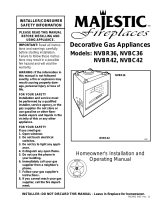 Majestic Appliances NVBR36EP User manual
Majestic Appliances NVBR36EP User manual
-
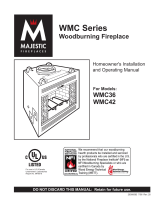 CFM Corporation WarmMajic WMC42 User manual
CFM Corporation WarmMajic WMC42 User manual
-
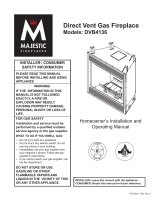 Majestic Appliances DVB4136 User manual
Majestic Appliances DVB4136 User manual
-
Vermont Casting DVHVAC36 User manual
Other documents
-
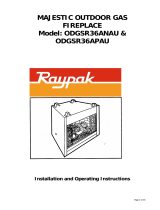 Majestic Appliances ODGSR36APAU User manual
Majestic Appliances ODGSR36APAU User manual
-
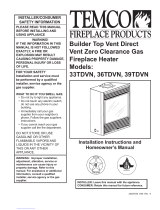 Temco 36TDVN Installation Instructions And Homeowner's Manual
Temco 36TDVN Installation Instructions And Homeowner's Manual
-
Vermont Casting DVT38S2IN User manual
-
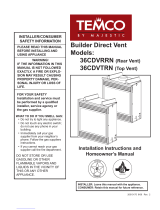 Temco 36CDVTRN User manual
Temco 36CDVTRN User manual
-
Vermont Casting EWF30 User manual
-
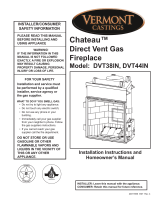 CFM Corporation DVT38IN User manual
CFM Corporation DVT38IN User manual
-
Vermont Casting LHECDV30 User manual
-
Vermont Castings 36BDVT Operating instructions
-
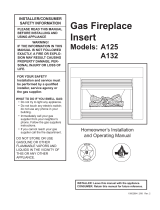 CFM Corporation A125 User manual
CFM Corporation A125 User manual
-
Vermont Casting ODSR42A User manual































